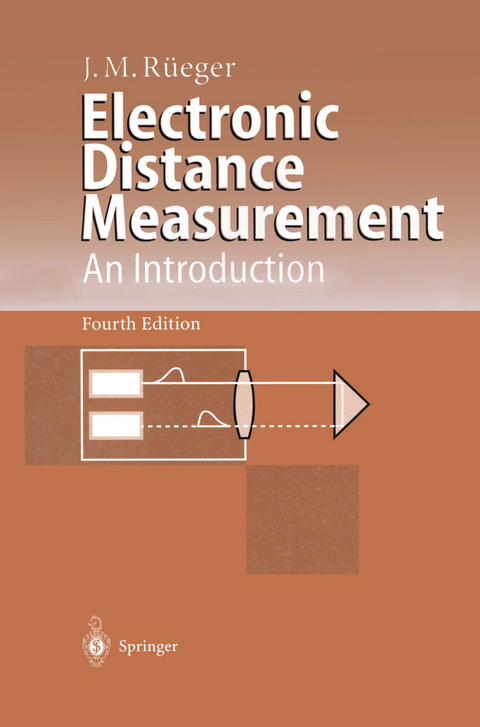
Electronic Distance Measurement
Springer Berlin (Verlag)
9783540611592 (ISBN)
As the basic principles of EDM instruments have changed little since the third edition of 1990, there was no need for significant changes. This edition differs from its predecessor in that it contains corrections of a number of errors and misprints, totally revised tables in Appendices D, E and F and a new note in Section 2. 4. 3 on the introduction of the new temperature scale in 1990. The author is indebted to the many readers who reported the many small errors and misprints. T. Black, H. Buchanan, R. Da-Col, R. Kochle, P. H. Lam, 1. Nolton, 1. R. Pollard and A. Quade were particularly helpful. All known errors have been corrected. The assistance pro vided by most manufacturers (or their agents) with the updating of the tables with the instrument data was greatly appreciated. Sydney, February 1996 1. M. RUEGER v Preface The book has evolved from the author's continuing teaching of the subject and from two editions of a text of the same title. The first edition was published in 1978 by the School of Surveying, Universi ty of New South Wales, Sydney, Australia. Like its predecessors, this totally revised third edition is designed to make the subject matter more readily available to students proceeding to degrees in Survey ing and related fields.
Based on the enormous teaching experience of the author, this book is a valuable source of information for students and practitioners interested in distance measurement.
1 History.- 2 Physical Laws and Units Related to EDM.- 2.1 Definitions.- 2.2 Frequency Spectrum.- 2.3 Velocity of Light in a Vacuum.- 2.4 Units and Their Definitions.- 3 Principles and Applications of EDM.- 3.1 Pulse Method.- 3.2 Phase Difference Method.- 3.3 Doppler Methods.- 3.4 Interferometry.- 4 Basic Working Principles of Electronic Distance Meters.- 4.1 Electro-Optical Instruments.- 4.2 Microwave Instruments.- 5 Propagation of Electromagnetic Waves Through the Atmosphere.- 5.1 Atmospheric Transmittance.- 5.2 Range of EDM Instruments.- 5.3 Phase Refractive Index.- 5.4 Group Refractive Index of Light and NIR Waves for Standard Conditions.- 5.5 Group Refractive Index of Light and NIR Waves at Ambient Conditions.- 5.6 Refractive Index of Microwaves.- 5.7 Coefficient of Refraction.- 5.8 Measurement of Atmospheric Parameters.- 5.9 Determination of the Refractive Index.- 6 Velocity Corrections to Measured Distances.- 6.1 Reference Refractive Index.- 6.2 First Velocity Correction.- 6.3 Real-Time Application of First Velocity Correction by EDM Instrument.- 6.4 Second Velocity Correction.- 6.5 Refined Method of Reduction of Measured Distance to Wave Path Chord.- 7 Geometrical Corrections.- 7.1 Reduction to the Spheroid Using Station Heights.- 7.2 Reduction to the Spheroid, Using Measured Zenith Angles.- 8 Miscellaneous Corrections, Computations and Numerical Examples.- 8.1 Correction of Measured Distance to Zenith Angle Ray Path.- 8.2 Eye-to-Object Corrections for Zenith Angles and Distances.- 8.3 Height Difference from Measured Zenith Angle(s) and Slope Distance.- 8.4 Determination of the Coefficient of Refraction from Reciprocal Zenith Angle Measurements.- 8.5 Reduction to Centre of Distances.- 8.6 Numerical Examples.- 9 Electro-Optical Distance Meters.- 9.1 Classification of Electro-Optical Distance Meters.- 9.2 Design of Some Electro-Optical Distance Meters.- 10 Reflectors.- 10.1 Introduction.- 10.2 Glass Prism Reflectors.- 11 Batteries and Other Power Sources.- 11.1 Review of Power Sources.- 11.2 Batteries Used in EDM.- 11.3 Sealed Nickel-Cadmium Batteries.- 12 Errors of Electro-Optical Distance Meters.- 12.1 Additive Constant.- 12.2 Short Periodic Errors.- 12.3 Scale Errors.- 12.4 Non-Linear Distance-Dependent Errors.- 12.5 Summary and Mathematical Model of Errors.- 13 Calibration of Electro-Optical Distance Meters.- 13.1 Introduction.- 13.2 Calibration on EDM Baselines.- 13.3 Calibration on Cyclic Error Testlines.- 13.4 Calibration of Modulation Frequency.- 13.5 Accuracy Specifications of EDM Instruments.- Appendices.- A. First Velocity Correction for Precise Electro-Optical Distance Measurement.- B. Tables of Saturation Water Vapour Pressures.- C. Parameters of the ICAO Standard Atmosphere.- D. Data of a Selection of Electro-Optical Distance Meters as Required for the Derivation of the First Velocity Correction and for Calibration Purposes.- E. Technical Data of a Selection of Short Range Distance Meters.- F. Technical Data of a Selection of Pulse Distance Meters.- G. Technical Data of a Selection of Long Range Distance Meters.- H. Critical Dimensions of a Selection of Reflectors.- References.
| Erscheint lt. Verlag | 17.9.1996 |
|---|---|
| Zusatzinfo | XIX, 276 p. |
| Verlagsort | Berlin |
| Sprache | englisch |
| Maße | 155 x 235 mm |
| Gewicht | 454 g |
| Themenwelt | Naturwissenschaften ► Geowissenschaften ► Geologie |
| Naturwissenschaften ► Geowissenschaften ► Geophysik | |
| Schlagworte | Distance measurement • Electronics in surveying • Elektronik in der Vermessung • Elektronische Messtechnik • Entfernungsmessung • Levelling • NIR • Nivellierung • Refractive index • Refraktionsindex • Satellite • Surveying instruments • Vermessungsinstrumente |
| ISBN-13 | 9783540611592 / 9783540611592 |
| Zustand | Neuware |
| Informationen gemäß Produktsicherheitsverordnung (GPSR) | |
| Haben Sie eine Frage zum Produkt? |
aus dem Bereich


